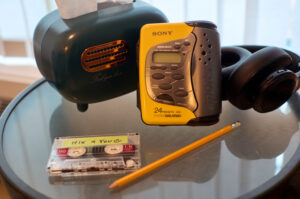Nostalgia has been hitting music formats again—cassettes have been making a comeback. The ballad of the cassette tape is revolutionary but short, holds a special place in the hearts of Gen X, and includes a pencil.
First off, cassette tapes were made for dictation, not music, due to the ease of recording. However, that’s why cassettes took off in music—anyone could record anywhere with minimal equipment. All that was needed to record was, at its crudest, a boombox and a quiet place. Independent bands could record albums and make demos on cassettes without high studio costs.
The cassette tape was first introduced by Philips in 1963 at the Berlin Radio Show. Despite the debut of cassette home stereos in 1964 (hello, mixtape); the first music album released on cassette in 1966; and the replacement of 8-track players with car cassette decks in 1968, it took 20 years before cassettes became the most popular music format. That claim was short-lived as CDs started outselling cassettes at the end of the ’80s.

The sound was turned up by Sony’s introduction of the Walkman in 1979—the portable music player that revolutionized how people listened to music. For the first time, people could easily listen to their music wherever they went.
In 2017, a resurgence started. Billboard magazine credits Guardian of the Galaxy as helping with bringing back the nostalgic music format, as main character Peter Quill had a Sony Walkman and his “Awesome Mix” tapes, which were released on cassette.
According to 2023 cassette record sales, the Guardians of the Galaxy theory appears sharp. The top five spots for highest cassette sales goes to Guardians of the Galaxy Vol. 1: Awesome Mix Vol. 1, Guardians of the Galaxy Vol. 2: Awesome Mix Vol. 2, and Guardians of the Galaxy Vol. 3: Awesome Mix Vol. 3 holding spots one, three, and four respectively and Taylor Swift’s 1989 (Taylor’s Version) and Speak Now (Taylor’s Version) holding two and five.
Another helpful factor for the cassette revival were the supply-chain issues vinyl pressing plants saw during the pandemic. To make up for the lack of vinyl, artists turned to other formats, including cassettes.
Sales of cassettes have made a significant increase: 81,000 units were sold in the US in 2015 and 436,400 in 2023 (granted, that’s not exactly the 450 million sold in the US in 1988). Artists like Swift and Maren Morris are putting out new albums on cassette, while record companies are re-releasing albums on cassette, but in smaller runs than CDs.
It’s not cassette tapes themselves that Gen X speaks fondly of—it’s mixtapes. Prior to pirating music online, Gen X was recording music off the radio onto cassettes, hopefully without the DJ, or anyone else in the room, talking. With a double cassette deck, songs were recorded from the radio recording or purchased music onto a blank tape to create a mixtape.
These curated tapes were given as gifts to friends or used to introduce people to new music. It was special because everyone knew how much time and effort it took to create a mixtape. Some people would create their own inserts to personalize the mixtape even more.
There’s been a long-standing Gen X joke that the younger generations will never know what a pencil has to do with cassette tapes. The explanation is simple: when the magnetic tape of a cassette accidentally gets caught in the player and unravels, the hexagonal shape of a pencil fits well into the wheels of a cassette tape, making it easier to wind up to fix.
The pencil, the mixtapes, being able to do it yourself: all part of the enduring nostalgia of cassettes, and just some of the reasons why they’ll always have a special place in music history.
